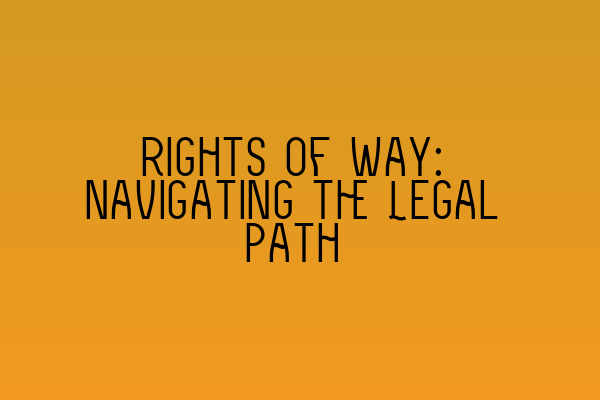Rights of Way: Navigating the Legal Path
Introduction:
As a property owner or someone looking to purchase a property, understanding the concept of rights of way is crucial. This legal term refers to the legal right to cross or use a portion of someone else’s land for travel or access. Whether you are considering buying a property with an existing right of way or have concerns about your own property’s access, it is essential to have a solid grasp of the legalities surrounding this topic. In this blog post, we will explore the rights of way in detail, including their types, creation, termination, and resolving disputes. Let’s start our journey!
Types of Rights of Way:
1. Public rights of way:
Public rights of way are paths, trails, or roads that are established and maintained by the government for public use. These can include footpaths, bridleways, and carriageways. They are usually marked on maps and visible on the ground, ensuring easy identification and access.
2. Private rights of way:
Private rights of way, as the name suggests, are rights that are exclusively granted to specific individuals or groups. Such rights are typically included in the deeds when purchasing a property. They enable property owners to access their property through certain routes over neighboring land.
3. Prescriptive rights of way:
Prescriptive rights of way are rights that arise over time through continued use without explicit permission. If someone consistently and openly uses a pathway or access route without interruption for a specified period, usually 20 years, they may be entitled to claim a prescriptive right of way.
4. Easements:
Easements are similar to rights of way but may cover other types of rights, such as the right to install and maintain utilities, drainpipes, or cables across someone else’s land. While not limited to access rights, easements play a vital role in ensuring the functionality of properties and utilities.
Creating a Right of Way:
There are several ways in which a right of way can be legally created:
1. Express Grant:
The most common method of creating a right of way is through an express grant. This involves the landowner granting the right in writing, usually within the property’s title deeds. The terms and conditions, such as the scope and limitations of the right, should be clearly defined and agreed upon by both parties.
2. Implication:
A right of way can also be implied based on the circumstances surrounding the property. For example, if a property is sold with a section of land that is completely surrounded by the seller’s land, it can be inferred that the new owner requires a right of way over the seller’s land to access their property.
3. By Necessity:
In certain situations, a right of way may be created out of necessity. For instance, if a property is landlocked and has no direct access to a public road, a right of way may be implied by necessity to ensure the property’s functionality.
Terminating a Right of Way:
Rights of way can be terminated under specific circumstances, including:
1. Expiration:
If the right of way was granted for a specific period, such as during a construction project, it may expire once the purpose is fulfilled.
2. Merger:
If the property benefiting from the right of way and the property burdened by the right of way are owned by the same person, the right of way may merge, rendering it unnecessary.
3. Abandonment:
If the party benefiting from the right of way stops using it with no intention to resume, it may be considered abandoned. However, abandonment can be a complex legal matter and requires evidence of intention to abandon.
Resolving Disputes:
Disputes regarding rights of way can arise between property owners, leading to stressful situations. Here are some steps to help resolve such disputes:
1. Communication:
In most cases, disputes can be resolved through open and respectful communication between the parties involved. Discuss your concerns, clarify misunderstandings, and explore the possibility of an amicable solution.
2. Mediation:
If direct communication fails, seeking assistance from a mediator can be a valuable step. Mediation involves a neutral third party who facilitates communication, allowing both parties to express their concerns and work towards a mutually beneficial resolution.
3. Legal Action:
In certain circumstances, legal action may be necessary to protect your rights or resolve a dispute. Consulting with a knowledgeable property law solicitor is essential to understand the legal options available to you and navigate the complex litigation process effectively.
Conclusion:
Rights of way are an integral part of property law, ensuring access, and functionality for property owners. Understanding the types, creation, termination, and resolution of disputes surrounding rights of way is crucial for property purchasers and owners. Should you encounter any issues or have questions regarding rights of way, it is highly recommended to seek guidance from a qualified property law professional to ensure that your rights are protected and your access is secure. By having a firm grasp of rights of way, you can navigate the legal path with confidence and peace of mind.
